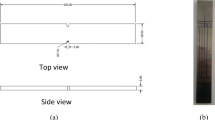Abstract
Tension-compression fatigue test was performed on 0.45% C steel specimens. Normal and tangential components of magnetic memory testing signals, H p(y) and H p(x) signals, with their characteristics, K of H p(y) and H p(x)M of H p(x), throughout the fatigue process were presented and analyzed. Abnormal peaks of H p(y) and peak of H p(x) reversed after loading; H p(y) curves rotated clockwise and H p(x) curves elevated significantly with the increase of fatigue cycle number at the first a few fatigue cycles, both H p(y) and H p(x) curves were stable after that, the amplitude of abnormal peaks of H p(y) and peak value of H p(x) increased more quickly after fatigue crack initiation. Abnormal peaks of H p(y) and peak of H p(x) at the notch reversed again after failure. The characteristics were found to exhibit consistent tendency in the whole fatigue life and behave differently in different stages of fatigue. In initial and crack developing stages, the characteristics increased significantly due to dislocations increase and crack propagation, respectively. In stable stage, the characteristics remained constant as a result of dislocation blocking, K value ranged from 20 to 30 A/(m·mm)−1, and H p(x)M ranged from 270 to 300 A/m under the test parameters in this work. After failure, both abnormal peaks of H p(y) and peak of H p(x) reversed, K value was 133 A/(m·mm)−1 and H p(x)M was −640 A/m. The results indicate that the characteristics of H p(y) and H p(x) signals were related to the accumulation of fatigue, so it is feasible and applicable to monitor fatigue damage of ferromagnetic components using metal magnetic memory testing (MMMT).
Similar content being viewed by others
References
KHOTSYANOVSKII A O. Life prediction of titanium and aluminum alloys under fretting fatigue conditions using various crack propagation criteria. Part 2: Application of the technique to cylindrical specimens with semi-elliptical crack and account of the residual stresses [J]. Strength of Materials, 2011, 43(1): 42–55.
STEPASHIN A M, YUNIN G N. Express evaluation of an index characterizing the contact fatigue strength of railroad rails [J]. Metallurgist, 2009, 53(9/10): 555–559.
DUBOV A A. A study of metal properties using the method of magnetic memory [J]. Metal Science and Heat Treatment, 1997, 39(9/10): 401–402.
DUBOV A A. Express method of quality control of a spot resistance welding with usage of metal magnetic memory [J]. Welding in the World, 2002, 46(Spec): 317–320.
DONG Li-hong, XU Bin-shi, DONG shi-yun, SONG Li, CHEN Qun-zhi, WANG Dan. Stress dependence of the spontaneous stray field signals of ferromagnetic steel [J]. NDT&E International, 2009, 42:323–327.
JIAN Xing-liang, JIAN Xing-chao, DENG Guo-yong. Experiment on relationship between the magnetic gradient of low-carbon steel and its stress [J]. Journal of Magnetism and Magnetic Materials, 2009, 321: 3600–3606.
BONAVOLONTÀ C, PELUSO G, VALENTINO M, IORIO A D, PENTA F. Detection of magnetomechanical effect in structural steel using squids and flux-gate sensors [J]. Journal of Superconducting and Novel Magnetism, 2009, 22: 833–839.
DONG Li-hong, XU Bin-shi, DONG Shi-yun, CHEN Qun-zhi, WANG Dan. Monitoring fatigue crack propagation of ferromagnetic materials with spontaneous abnormal magnetic signals [J]. International Journal of Fatigue, 2008, 30: 1599–1605.
LENG Jian-cheng, XU Min-qiang, XU Ming-xiu, ZHANG Jia-zhong. Magnetic field variation induced by cyclic bending stress [J]. NDT&E International, 2009, 42: 410–414.
KATSUYUKI K, EDSON C, SANTOS T H, HITONOBU K, JUSTYNA R. Observation of magnetic flux density around fatigue crack tips in bearing steel using an SHPM with a three-dimensional small-gap probe [J]. International Journal of Fatigue, 2012, 39: 38–43.
WANG Zheng-dao, YAO Kai, DENG Bin, DING Ke-quan. Theoretical studies of metal magnetic memory technique on magnetic flux leakage signals [J]. NDT&E International, 2010, 43: 354–359.
WANG Zheng-dao, YAO Kai, DENG Bin. Physical model of plastic deformation on magnetization in ferromagnetic materials [J]. Journal of Applied Physics, 2011, 109: 083928.
ROSKOSZ M. Metal magnetic memory testing of welded joints of ferritic and austenitic steels [J]. NDT&E International, 2011, 44: 305–310.
ROSKOSZ M, GAWRILENKO P. Analysis of changes in residual magnetic field in loaded notched samples [J]. NDT&E International, 2008, 41: 570–576.
SUN Yan-hua, KANG Yi-hua, QIU Chen. A new NDT method based on permanent magnetic field perturbation [J]. NDT&E International, 2011, 44: 1–7.
DONG Li-hong, XU Bin-shi, DONG shi-yun, CHEN Qun-zhi, WANG Dan, YIN Da-wei. Metal magnetic memory signals from the surface of low-carbon steel and low-carbon ally steel [J]. Journal of Central South University of Technology, 2007, 14(1): 24–27.
JIANG Shou-ting, LI Wei. Magnetic physics of the condensed matter [M]. Beijing: Science Press, 2003: 258–289. (in Chinese).
DEVINE M K, KAMINSKI D A, SIPAHI L B, JILES D C. Detection of fatigue in structural steels by magnetic property measurements [J]. Journal of Materials Engineering and Performance, 1992, 1: 249–254.
JILES D C, UTRATA D. Effects of tensile plastic deformation on the magnetic properties of AISI 4140 steel [J]. Journal of Nondestructive Evaluation, 1988, 6(3): 129–134.
MISRA A. Theoretical study of the fracture-induced magnetic effect in ferromagnetic materials [J]. Physics Letter A, 1977, 62(4): 234–6.
DONG Li-hong, XU Bin-shi, DONG shi-yun, CHEN Qun-zhi, WANG Dan. Variation of stress-induced magnetic signals during tensile testing of ferromagnetic steels [J]. DNT&E International. 2008, 41: 184–198.
Author information
Authors and Affiliations
Corresponding author
Additional information
Foundation item: Projects(50975283, 50975287) supported by the National Natural Science Foundation of China; Project(2011CB013401) supported by the National Basic Research Program, China
Rights and permissions
About this article
Cite this article
Wang, Hp., Dong, Lh., Dong, Sy. et al. Fatigue damage evaluation by metal magnetic memory testing. J. Cent. South Univ. 21, 65–70 (2014). https://doi.org/10.1007/s11771-014-1916-5
Received:
Accepted:
Published:
Issue Date:
DOI: https://doi.org/10.1007/s11771-014-1916-5




